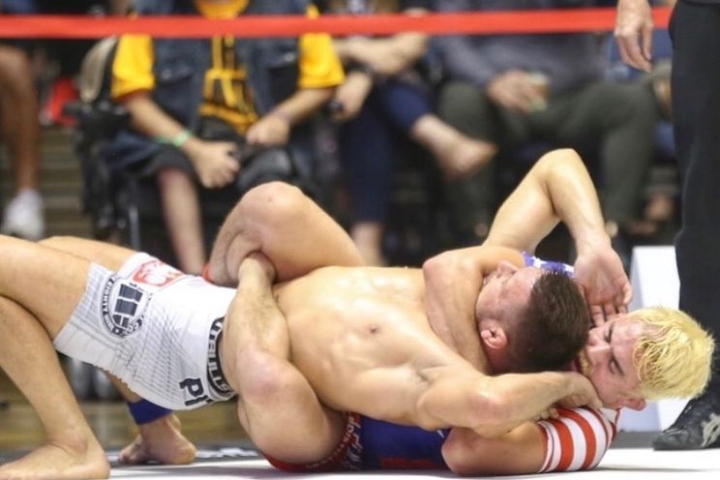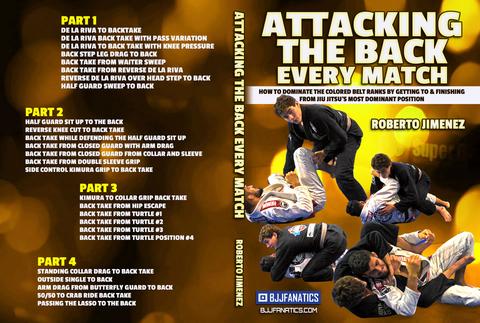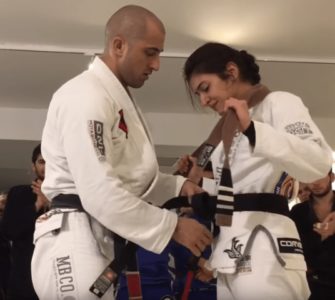Guest post by Evolve MMA, Asia’s premier championship brand for martial arts. It has the most number of World Champions on the planet. Named as the #1 ranked martial arts organization in Asia by CNN, Yahoo! Sports, FOX Sports, Evolve MMA is the top rated BJJ gym in Singapore.
The back mount is the most dominant grappling position in Brazilian Jiu-Jitsu. Many of our sport’s top athletes prefer the back as it is a strong position to not only control but also finish opponents. Generally, finishing opponents from behind while keeping them in place requires significant skill and an understanding of typical reactions. While this may already sound challenging, finding the path to the back and getting there is another topic worth discussing. In this article, we will talk about how to perform the rolling back take safely in BJJ.
The Rolling Back Take
The rolling back take, also known as the rolling back attack, is often seen as a flashy, eye-catching technique, yet it is practical and highly effective. When passing the guard, opponents usually defend in a specific way, which opens them up for the rolling back take. Anyone can safely train this technique. Although it requires familiarity with certain positions, the rolling back take is usually done from the 3/4 mount, reverse kesa gatame, and turtle position.
Starting from the 3/4 mount, where you have your knee on the other side. Hook your toes onto the opponent’s shin (top leg) to establish and maintain connection. Roll by placing your shoulder below the opponent’s hips and not above so that you won’t have to rely on momentum but rather on proper positioning. Try to avoid rolling over the opponent’s back as it has less chance of succeeding. One way to ensure you’re rolling at the correct angle is to grab the non-hooked leg (opponent’s bottom leg) with your hand.
This will force you to the correct angle, as you won’t be able to reach for the bottom leg otherwise. It can also be used as a controlling point to mitigate the opponent’s chances of escaping or countering the roll. However, you can still roll without hooking your toes, as sometimes you must roll swiftly before the opponent can prevent the back take. The more confident you become with using the imperfect entries, the better you can recover from a failed attempt, which may sometimes land you in side control, making it a low-risk but high-reward technique.
Another tool you can utilize is to push the heel of the hooked leg (opponent’s top leg) with your foot. As you roll, the goal is to have the opponent’s hips come across your body. Knee positioning is also critical as you don’t want your knee in between the opponent’s leg like in half guard, as it allows the opponent to take your back as you roll. Place your knee outside the quarter guard while the opponent’s knee faces the other side. Your knee should be pointing towards the opponent’s head as it is a mark that you already have the opponent’s back or in the truck position. Remember not to point your knee away from the opponent’s head, as the opponent can use this to reverse the roll and take your back. Understanding the proper knee positioning also allows you to counter your opponent’s rolling back take by moving your knee to the right spot.
Stopping your roll halfway through will put you in the truck position, giving you three submission options: the calf slicer, groin stretch, and twister. If you can’t get the opponent’s hips across your body, you can abandon the roll, unhook your foot, and move to side control, proving that the rolling back take is a low-risk, high-reward move.
Passing from the half guard is the most common position to get to the 3/4 mount to set up the rolling back take. Not getting your leg out of the half guard allows you to bring your knee to the opposite side, which puts you in the 3/4 mount. Another is from the mount, and the opponent hooks your leg to try and escape, allowing you to execute the roll efficiently.
Another high percentage position where you can execute the rolling back take is from the reverse kesa gatame, where the opponent faces your body, having your arm on the inside of their armpit. Pull the opponent’s top knee towards you from this setup and hook it to your heel. As you go to roll, move by hooking with your toes to get a solid connection. You can transition to the armbar if missed hooking with your toes. To do this, use your top hand (near hand) to grab the opponent’s waist from below to immobilize their hips, and start using your other hand to hold the opponent’s arm and set up the armbar.
You can enter into the reverse kesa gatame position with your arm on the inside of the opponent’s armpit when the opponent manages to get an underhook with their far arm from side control. You can use your arm to block their hip, come all the way, and transition to side control on the opposite side. This puts you in the position you need to execute the roll.
Likewise, from the north-south position, where you usually have one arm on the inside of the opponent’s armpit and one arm on the outside, move to side control on the side of the outside arm. Pull their knees towards you upon landing in side control and execute the roll. Another is when you’re going for a knee slide, and the opponent gets an underhook, you can perform a back step which lands you in the same position to execute the roll. The benefit is that you already have your leg hooked.
When the opponent turtles, you can shoot your knee in between their knee and elbow from the side before they can close the gap. This allows you to pull them back and take the back mount, put them in the truck position, or roll through for the rolling back attack.
Conclusion
The rolling back take is a helpful way to take the opponent’s back if your game rotates around back attacks. While this technique may seem challenging at first, with constant drilling and refinement, you’ll get used to the movements quickly. Constantly seek the back, and as John Danaher says, if you can see the back, you can take the back.
If you want to incorporate some slick back takes into your bjj game, make sure to get ‘Attacking the back every match’ by BJJ world champion Roberto Jimenez. You will learn techniques and concepts that will boost your back take game by like 800%. Your backtakes might get so good that you’ll just stop trying to get them, because it’s just too easy at this point.
Learn How To Turn Any Position Into A Road-Map To The Back, The Most Dominant Position In Jiu-Jitsu:



















